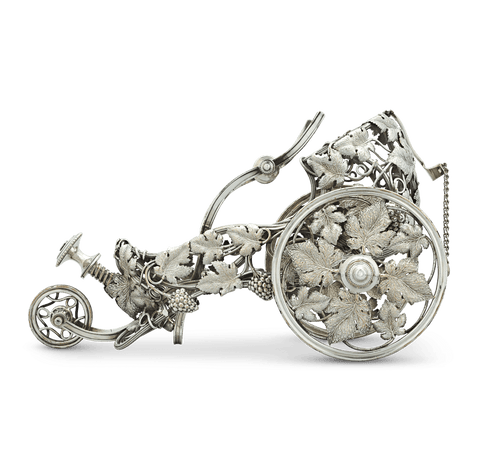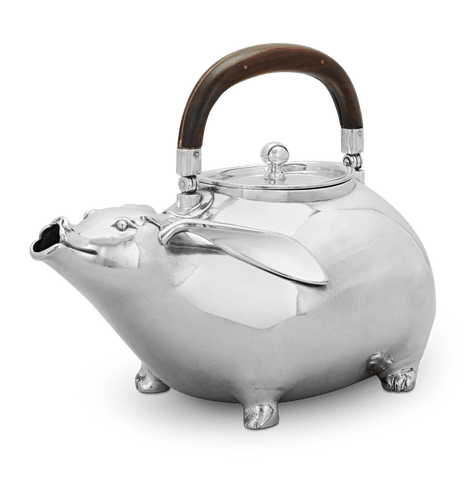Artists & Artisans
Christofle
Founded in 1830 by Charles Christofle, Christofle began as a Parisian metalwork business and would later grow to become a prestigious goldsmith of the era. Their creations revolutionized production and ranged from tableware to decorative art, including notable commissions for royalty inspiring the title "Goldsmith of the King." Christofle reigns supreme as the pinnacle of French flatware mastery, celebrated for its unrivaled elegance, beauty and craftsmanship. Christofle's exquisite designs epitomize the essence of luxury home goods.
After Christofle's death, his son Paul and his nephew Henri Bouilhet continued to grow the business, embracing new techniques and opening new factories. This grew Christofle into one of the major goldsmiths of the century and the company has stayed within the family— currently passed down through five generations to today.
History
Charles Christofle, born into a family of Parisian industrialists known for producing buttons, began his jewelry apprenticeship with his brother-in-law at 15. Assuming control of the family business in 1830, he registered his master’s mark for gold jewelry production two years later. Christofle was a born visionary, and he quickly began to innovate within his time-honored craft. He patented metallic fabric manufacturing in 1837, diversifying into silver filigree and military adornments, and earned accolades at national exhibitions, including a gold medal in Paris in 1844. Acquiring patents for silver and gold electroplating in 1842, Christofle revolutionized production methods that were more durable and less harmful to artisans, becoming France's sole patent holder for this technique for 15 years.After Christofle's death, his son Paul and his nephew Henri Bouilhet continued to grow the business, embracing new techniques and opening new factories. This grew Christofle into one of the major goldsmiths of the century and the company has stayed within the family— currently passed down through five generations to today.
Significant Clientele
King Louis-Philippe ordered a dinner service for the Château d'Eu in 1846 and Emperor Napolean III ordered a 4,000-piece service in 1851. The centerpiece of this service was recovered and is now on view at the Museum of Decorative Arts in Paris. After rising to international fame through these royal associations, the company received commissions from many prestigious clientele, including Emperor Maximilian of Mexico, the Tsar of Russia, the German Kaiser, the Austro-Hungarian Empire and the Sultan Abdülaziz of the Ottoman Empire. Their services could also be found on board the Orient Express and the Trans-Siberian Railway.Legacy
Today the workshop site in Paris is registered as a historical monument and can be visited as the Bouilhet-Christofle Goldsmiths' Museum. Production of Christofle wares continues in Yainville, Normandy. Over the years, the brand has collaborated with esteemed designers such as Ora-ïto, Martin Szekely, Andrée Putman, Gio Ponti, Man Ray, and most recently, Ramdane Touhami. The brand introduced Idole de Christofle in 2023, marking its debut gold and diamond jewelry collection. Additionally, Christofle has recently forged a partnership with the illustrious French Open, a premier tennis tournament. Emblematic of its ethos, Christofle transcends mere arts de la table (the art of entertaining) to embody arts sur la table (art on the table) — a testament to its unwavering commitment to infusing artistry into every dining experience.Quick Facts
- Before electroplating, workers used a harmful amalgam of gold or silver with mercury. Electroplating enabled high-quality metal application without such risks to the artisans.
- All Christofle flatware is held to the highest standard and must pass through 52 people, an impressive process known as “100 hands.”
- All modern Christofle flatware is designed to be dishwasher safe.
- Christofle silverware bears marks like '925' indicating 92.5% silver content. '800' denotes silver-plated items, not sterling silver.
Artists & Artisans
Christofle
Founded in 1830 by Charles Christofle, Christofle began as a Parisian metalwork business and would later grow to become a prestigious goldsmith of the era. Their creations revolutionized production and ranged from tableware to decorative art, including notable commissions for royalty inspiring the title "Goldsmith of the King." Christofle reigns supreme as the pinnacle of French flatware mastery, celebrated for its unrivaled elegance, beauty and craftsmanship. Christofle's exquisite designs epitomize the essence of luxury home goods.
After Christofle's death, his son Paul and his nephew Henri Bouilhet continued to grow the business, embracing new techniques and opening new factories. This grew Christofle into one of the major goldsmiths of the century and the company has stayed within the family— currently passed down through five generations to today.
History
Charles Christofle, born into a family of Parisian industrialists known for producing buttons, began his jewelry apprenticeship with his brother-in-law at 15. Assuming control of the family business in 1830, he registered his master’s mark for gold jewelry production two years later. Christofle was a born visionary, and he quickly began to innovate within his time-honored craft. He patented metallic fabric manufacturing in 1837, diversifying into silver filigree and military adornments, and earned accolades at national exhibitions, including a gold medal in Paris in 1844. Acquiring patents for silver and gold electroplating in 1842, Christofle revolutionized production methods that were more durable and less harmful to artisans, becoming France's sole patent holder for this technique for 15 years.After Christofle's death, his son Paul and his nephew Henri Bouilhet continued to grow the business, embracing new techniques and opening new factories. This grew Christofle into one of the major goldsmiths of the century and the company has stayed within the family— currently passed down through five generations to today.
Significant Clientele
King Louis-Philippe ordered a dinner service for the Château d'Eu in 1846 and Emperor Napolean III ordered a 4,000-piece service in 1851. The centerpiece of this service was recovered and is now on view at the Museum of Decorative Arts in Paris. After rising to international fame through these royal associations, the company received commissions from many prestigious clientele, including Emperor Maximilian of Mexico, the Tsar of Russia, the German Kaiser, the Austro-Hungarian Empire and the Sultan Abdülaziz of the Ottoman Empire. Their services could also be found on board the Orient Express and the Trans-Siberian Railway.Legacy
Today the workshop site in Paris is registered as a historical monument and can be visited as the Bouilhet-Christofle Goldsmiths' Museum. Production of Christofle wares continues in Yainville, Normandy. Over the years, the brand has collaborated with esteemed designers such as Ora-ïto, Martin Szekely, Andrée Putman, Gio Ponti, Man Ray, and most recently, Ramdane Touhami. The brand introduced Idole de Christofle in 2023, marking its debut gold and diamond jewelry collection. Additionally, Christofle has recently forged a partnership with the illustrious French Open, a premier tennis tournament. Emblematic of its ethos, Christofle transcends mere arts de la table (the art of entertaining) to embody arts sur la table (art on the table) — a testament to its unwavering commitment to infusing artistry into every dining experience.Quick Facts
- Before electroplating, workers used a harmful amalgam of gold or silver with mercury. Electroplating enabled high-quality metal application without such risks to the artisans.
- All Christofle flatware is held to the highest standard and must pass through 52 people, an impressive process known as “100 hands.”
- All modern Christofle flatware is designed to be dishwasher safe.
- Christofle silverware bears marks like '925' indicating 92.5% silver content. '800' denotes silver-plated items, not sterling silver.





